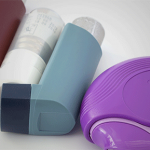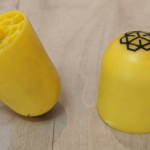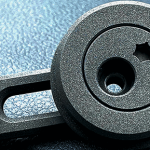- Home
- 3D Printing
- Six disadvantages of SLS
Six disadvantages of SLS
SLS, or Selective Laser Sintering, is quick and cost-effective for 3D printing prototype parts and, in the right circumstances, end-use parts. Simply put, parts are built, layer by layer from the bottom up, with a computer-controlled laser beam fusing fine white plastic powder. However, it is not a ‘silver bullet’ for rapid prototyping and rapid manufacturing. To be honest, the technology has its downsides, so in this article, we will explore six disadvantages of SLS.
1. SLS 3D printed parts are porous
SLS 3D printed parts are porous compared with parts made using technologies such as SLA, DLP or PµSL. However, if you were to 3D print a cup using SLS, it would hold water.
Depending on the application and the operating conditions, this low-level porosity might be a problem, or it might not. Fortunately, if porosity is an issue, it can be addressed by applying a lacquer to seal the part’s surfaces, which is one of the many finishing options we offer.
2. SLS 3D printed parts suffer from warpage
As part of the overall SLS 3D printing process, the powder is heated up within the build chamber, a laser raises the temperature high enough to melt the powder granules and fuse them together in a controlled way. This heating is then followed by a controlled cool-down.
As you can see, every area of the part undergoes significant thermal cycling as part of the build process, and it has to be done in a tightly controlled way to avoid thermal shock.
Finished parts can contain residual stresses and, depending on the part’s geometry, these internal stresses can result in warpage.
Furthermore, if the finished part is used in an environment where the operating temperature exceeds the maximum recommended on the material data sheet, distortion and warpage can occur.
Something to remember is that injection moulded parts can also suffer from warpage and distortion. In this case, it will depend on the part geometry, mould tool design (including cooling channels), moulding cycle parameters and the temperature of the operating environment. Consequently, an SLS 3D printed part may not distort in the same way as a geometrically identical injection moulded part.
For SLS parts, warpage can be reduced by means of careful part design (we can provide advice if required) and build orientation. It is also important to check that the temperature of the environment in which the finished part will be used is within the permitted range.
Of course, if warpage must be avoided and this cannot be achieved with SLS, remember that we have four other 3D printing technologies in-house, all of which can be used with a choice of materials. The chances are, therefore, that we can 3D print your parts so that they will not warp, but it may require the use of a 3D printing technology other than SLS.
3. SLS 3D printed parts have a poor surface finish and wide tolerances
You might expect that by using very fine powder and high-precision engineering to control the bed and laser optics, the surface finish would be excellent. Unfortunately, this is not the case, particularly in comparison with other 3D printing technologies such as SLA and DLP. The surface is perhaps best described as ‘mottled’, though it can be improved by light bead blasting.
If a better finish is required, surfaces can be sanded and polished or primed and painted, though these processes add time and cost.
Tolerances for SLS parts are not as good as those achieved using technologies such as SLA, PµSL and CNC machining. We quote a general tolerance on SLS parts of ±0.5 mm, which is the same as for parts built using SLA, DLP and PolyJet, but it is harder to hold ±0.5 mm with SLS. If parts are polished or painted to improve the visual appearance, this can adversely affect the tolerances, depending on the amount of finishing required and the skill of the operative.
If you need a high-quality surface finish and tight tolerances on your 3D printed part, it may be that SLS is simply not the right technology for your application. We recommend that you talk to our 3D printing specialists who can advise whether it would be best to use SLS or another 3D printing technology.
4. SLS parts have powder residue, encapsulated unsintered powder
Typically, we nest multiple parts and 3D print them simultaneously in one build. Afterwards, individual parts are carefully removed from the crumbly ‘cake’ surrounding them, then cleaned. This might involve brushing by hand, cleaning holes and internal passageways with pipe cleaners, and placing the parts in a vibratory cleaner. Customers can also specify a light bead blast, which helps to remove loose powder from the surfaces.
However, despite our best efforts, powder residues can remain, and these may be shed when the part is in use.
One of the advantages of SLS is that it can build hollow parts that cannot be manufactured by injection moulding. If a customer wants a hollow part, the design will require an escape hole, though two holes are always better than one if the geometry permits two. As the name suggests, escape holes allow the unsintered powder to escape, though it requires some ‘encouragement’ with compressed air, pipe cleaners and other implements. Internal voids can be difficult to clean completely, so there is a chance that uncured powder will be shed when the part is in use.
Be aware that some 3D printing bureaux do not routinely incorporate escape holes, so finished parts may contain voids filled with uncured powder of which the customer is unaware.
5. SLS parts cannot incorporate reliable living hinges
SLS parts are made by sintering a powder, so the finished parts contain small voids between the fused powder grains. Each void is potentially a weak point. When subjected to relatively high strains and stresses, as will occur within a living hinge, the voids can initiate cracks and cause failure.
If necessary, living hinges can be 3D printed using SLS but they will be nowhere near as reliable as an injection moulded equivalent. They may break after being flexed only a few times or just once, or you might be lucky and they last longer.
If we receive a CAD file for a part that has a living hinge, we contact the designer to discuss it before 3D printing the part.
6. SLS equipment is expensive to buy and operate
There are several reasons why SLS 3D printing equipment is expensive to buy and operate. First, the 3D printer incorporates a powerful laser and high-quality optics, as well as precision motion control systems. All this engineering is costly. At the same time, the machine’s designers have to take precautions to ensure there are no sources of ignition for the potentially explosive atmosphere caused by SLS powder being present in the air.
Furthermore, to provide an SLS 3D printing service you need far more than just a 3D printer and a room in which to operate it. You also need dedicated areas – equipped with Atex-rated dust extraction systems – where parts are removed from the powder cake and cleaned of loose powder using handheld implements, where necessary, light bead blasting. A vibratory cleaner is needed as part of the SLS suite, and we also offer SLS dyeing in almost any RAL or Pantone shade – which necessitates investment in additional equipment and dyes.
Because of the nature of the SLS powder, which can be hazardous under certain circumstances, care needs to be taken with storage, handling and disposal. This needs protocols to be written and followed, staff to be trained and appropriate spaces allocated.
Given the foregoing, most manufacturers and consultancies involved with prototyping prefer to use SLS 3D printing bureaux like Prototype Projects, rather than bringing the technology in-house.
Talk to us
If you want to discuss the pros and cons of SLS 3D printing with one of our experts or learn how it compares with alternative 3D printing technologies, contact us on 01763 249760 or complete the enquiry form below to request a quote.





